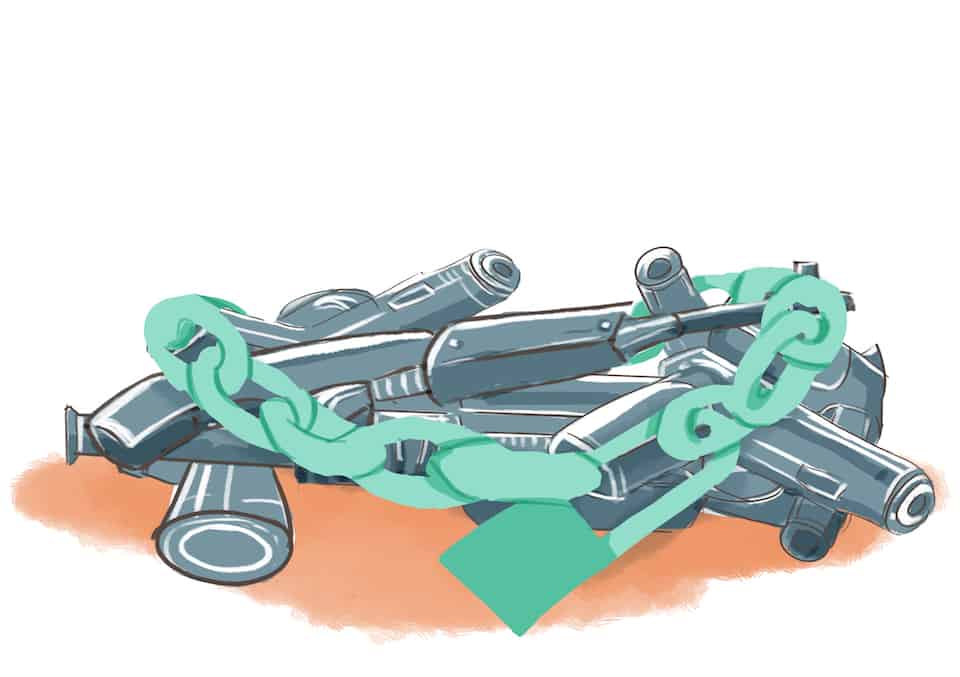[dropcap]A[/dropcap] recent article in The Varsity argued that Toronto police officers require the ability to use lethal force in order to protect the public. In fact, it was suggested that officers ought to “be more heavily armed.” This is in direct opposition to calls for disarmament advocated by the Black Lives Matter movement, a cause that has generated support at universities across North America.
Considering the possibility that police will be unprepared for emergencies, perhaps complete disarmament is impractical. We must also consider, however, the repercussions of readily granting police the ability to use lethal violence. This is particularly salient in light of the recent announcement that the Toronto Police Service will obtain military-grade C8 carbine assault rifles, which are so easy to use that an untrained CBC reporter used one of them to hit a bulls-eye.
To begin, the desire to arm police officers is often fueled by misconceptions about crime itself. A heavily armed police force is often framed as a reasonable response to an increasingly dangerous climate.
On the surface, this seems accurate, given that the Toronto Police Service cited a 29.6 per cent increase in shootings from 2014 to 2015. Yet, simultaneously, deaths by shooting decreased by 20 per cent in the city. The largest spike in shooting incidents were those in which shots were fired but no one was injured.
Because official crime statistics only reflect crimes that are reported to police, they depend heavily on how offences are reported and categorized. An apparent statistical increase in crime can be attributed to a targeted effort on the part of police departments to record more incidents, or to upticks in civilian cooperation with police.
Drawing conclusions merely from scratching the surface of police statistics can be misleading. In contrast, homicide rates in Canada — favoured by criminologists as far more reliable indicators of violent crime rates than shootings — are steadily declining.
When considering these figures, the picture becomes less bleak. Firearm-related homicides decreased by almost 50 per cent between 2008 and 2013, and 2014 saw the second-lowest firearm-related homicide rate recorded by Statistics Canada since the government started collecting data in 1974.
These trends conflict with the rhetoric and logic of those advocating for expanded police powers. The media, for instance, is saturated with stories of violent crime, “if it bleeds, it leads.” One glance at the evening news may compel even the least lily-livered Toronto residents to lobby for armament.
When pushing for increased crime control, police and politicians often recall extreme cases of gun violence, such as the 1991 Rainbow Motel shootout, or the more recent shooting in Moncton, New Brunswick, which took the lives of three RCMP officers.They neglect to mention, however, that these cases, despite being tragic, are actually few and far between.
There is also a tendency to conflate skyrocketing crime rates in the United States with the situation in Canada. While previously expressed opinions in The Varsity cite that, between 2000-2010, 40 per cent of incidents in the United States were resolved only when police shot the suspect, this data was limited to active shooter incidents, which are extremely uncommon north of the border.
It is questionable that the use of lethal violence by police officers is so readily justified. Although police are legally authorized to use this power, they are also supposed to be trained to use it only when necessary to stop serious injury or death — scenarios that are becoming statistical rarities in Toronto.
The potential for lethal force to be misused must be taken seriously. Recently, Constable James Forcillo was convicted of the attempted murder of 18-year-old Sammy Yatim. Though Yatim was “mentally troubled” and wielding a switchblade on an empty streetcar — suggesting that the officer ought to have prioritized non-lethal measures — the jury was convinced that the first three shots Forcillo fired were legitimate, in response to an allegedly “imminent threat.”
In this vein, the police have also been criticized for excessive violence at public demonstrations, including a heavily militarized response to demonstrations occurring during the 2010 G20 summit in Toronto.
Fortunately, there are a number of options to reduce police violence, including improved training within police sectors, and closely monitored reporting requirements in the event that force is used. Increased accountability measures are also necessary. Had the shooting of Sammy Yatim not been caught on video, for instance, there may have been no case against Forcillo at all. Implementing measures like these may encourage officers to prioritize other strategies before pulling the trigger.
In several cases, non-violent policing measures have in fact prevailed over traditional methods. Following the implementation of police training and community partnerships, and the frequent use of non-violent measures like Tasers, the municipality of Richmond, California experienced not only a drop in police violence, but also a significant drop in crime between 2003 and 2010. Most British police officers, operating on the principle of “policing by consent,” do not carry firearms at all. Strapping military- grade weapons to the belts of Toronto officers is clearly not the only option.
In most cases, police officers only intend to protect the public from harm, and it is not that we ought to tie their hands. However, as students, we ought to advocate for critical discourse and transparency within law enforcement, as well as push for alternatives to violence. It is crucial to dig deeper before signing away the ability to shoot and kill.
Teodora Pasca is a second-year student at Innis College studying criminology and ethics, society & law. She is The Varsity’s Associate Comment Editor. Her column appears every three weeks.


